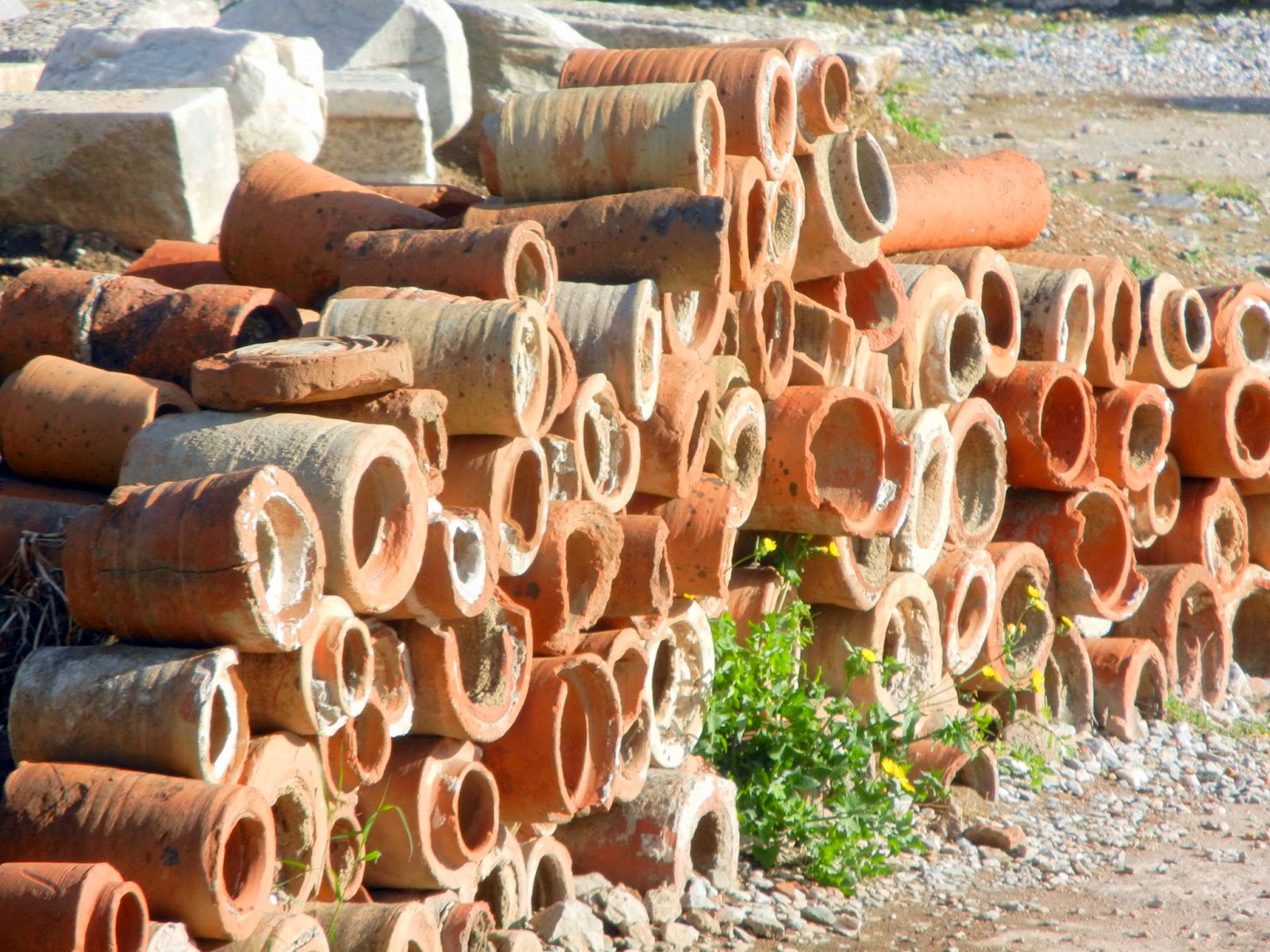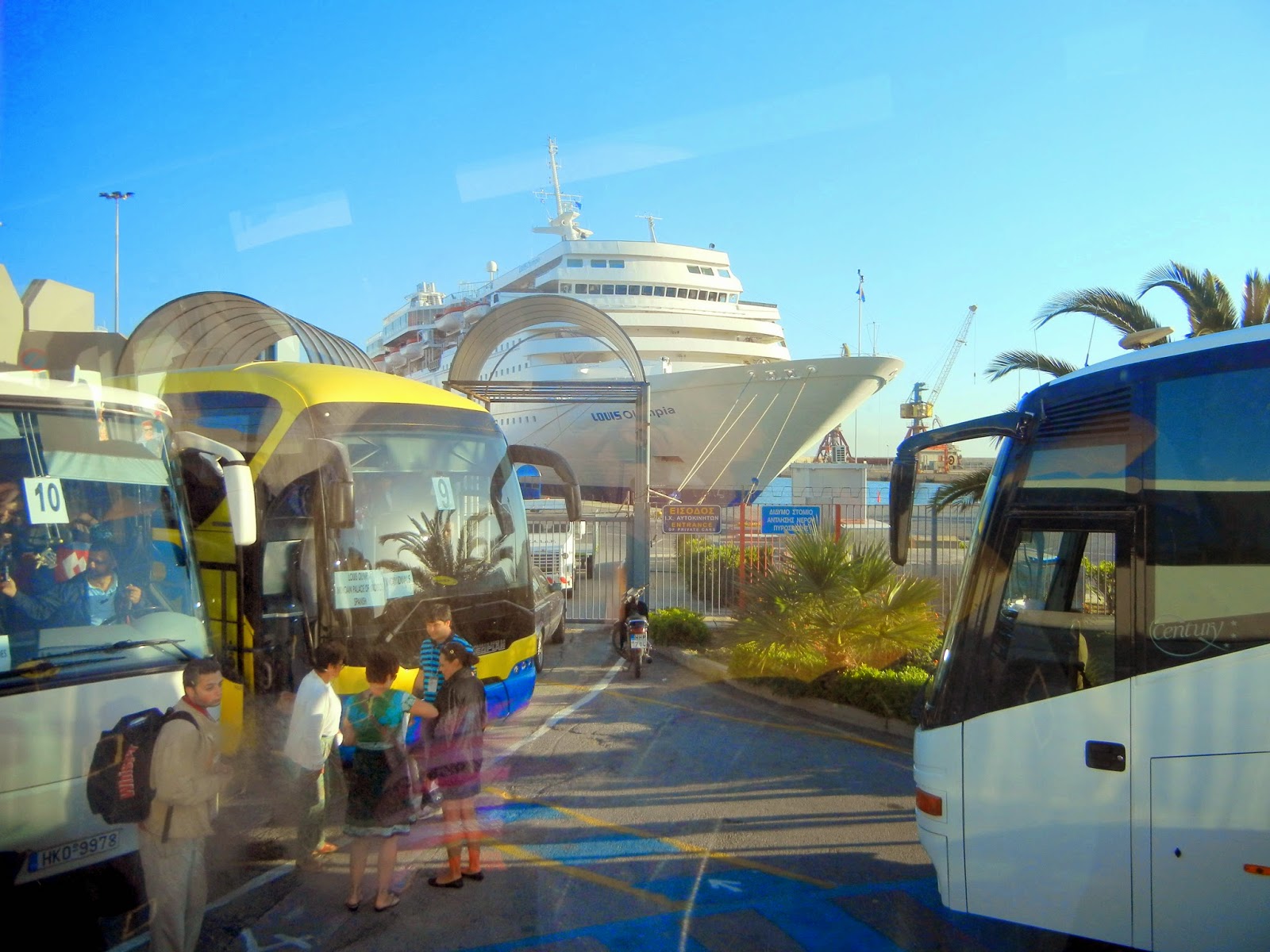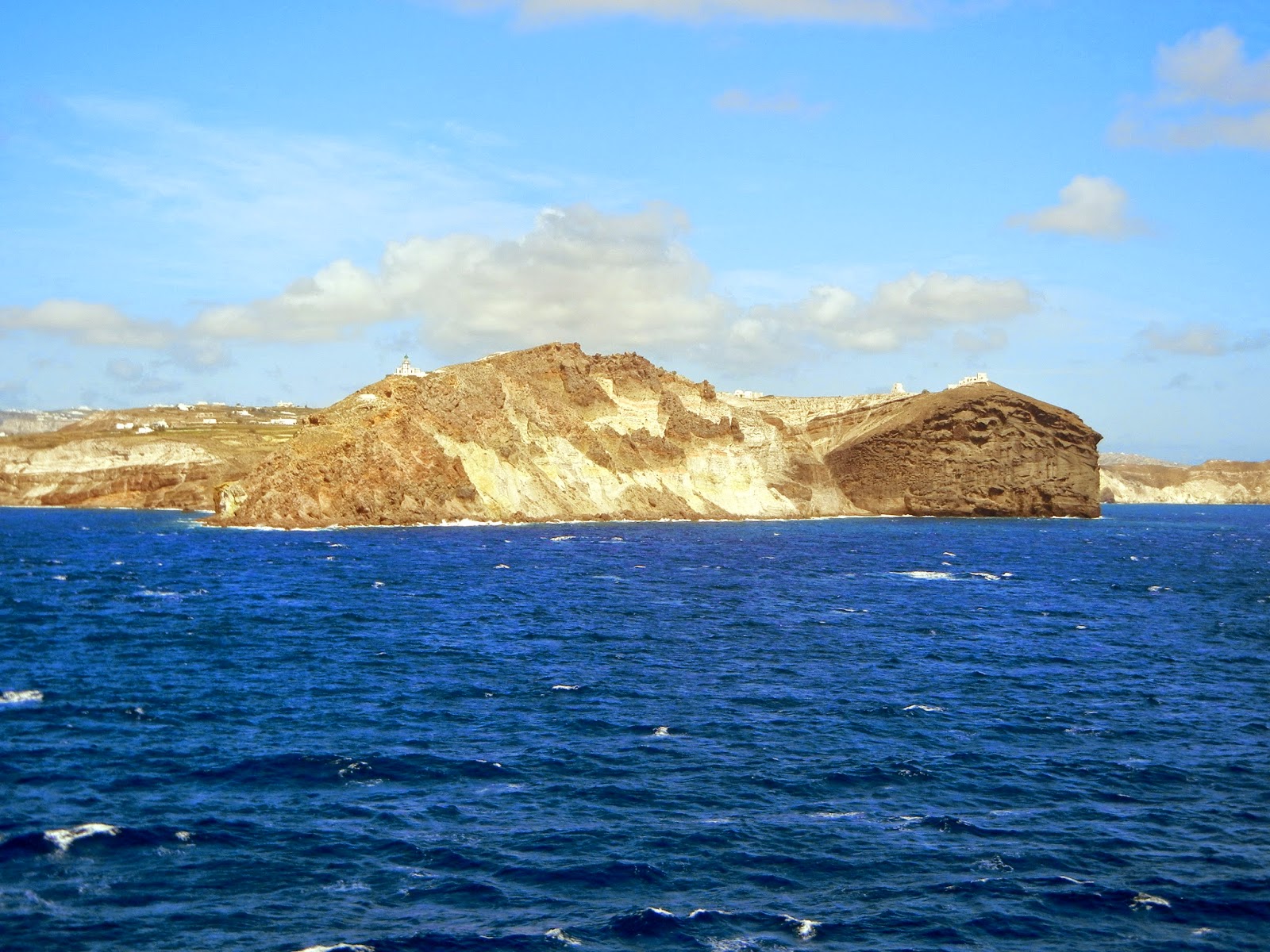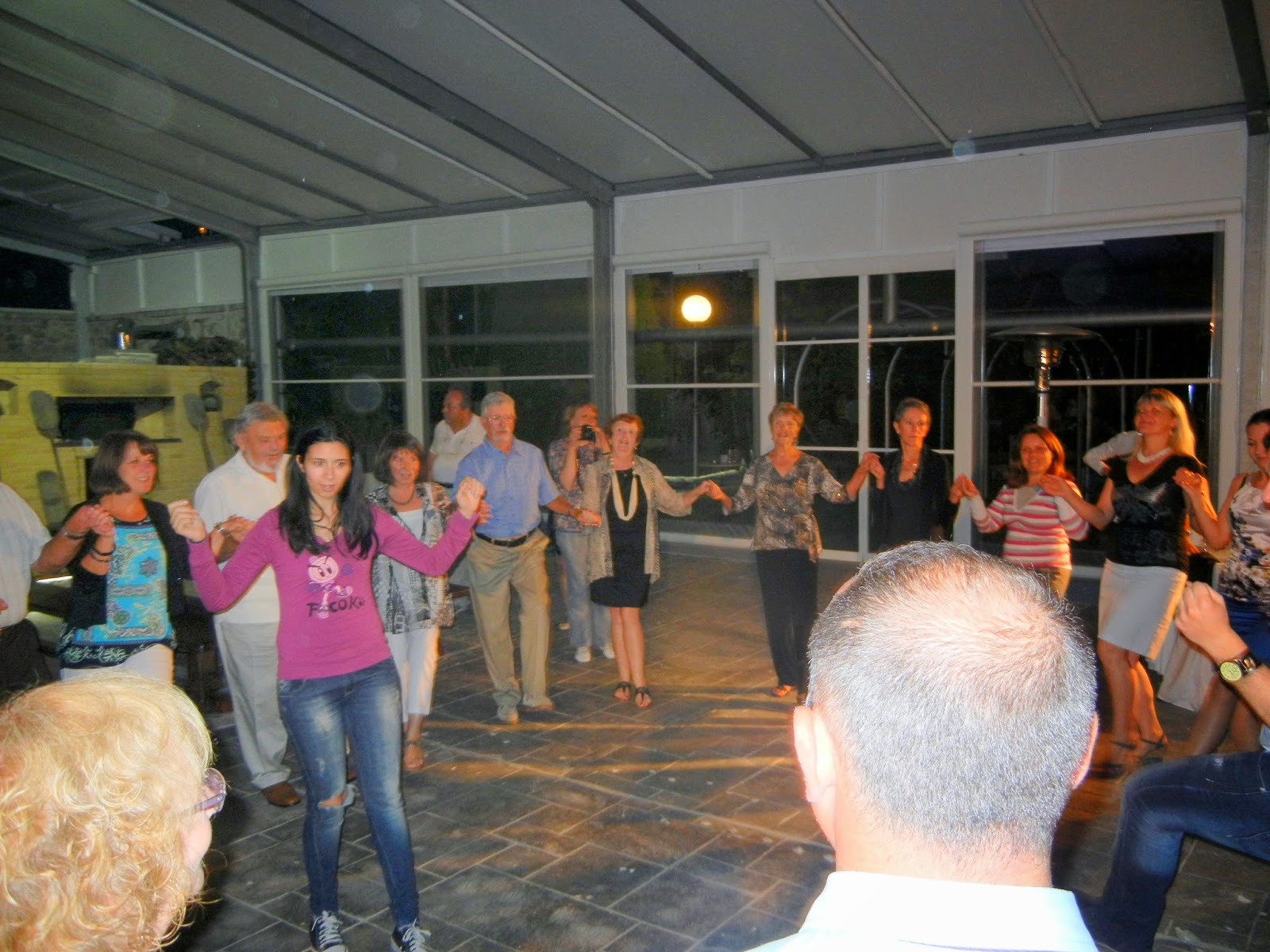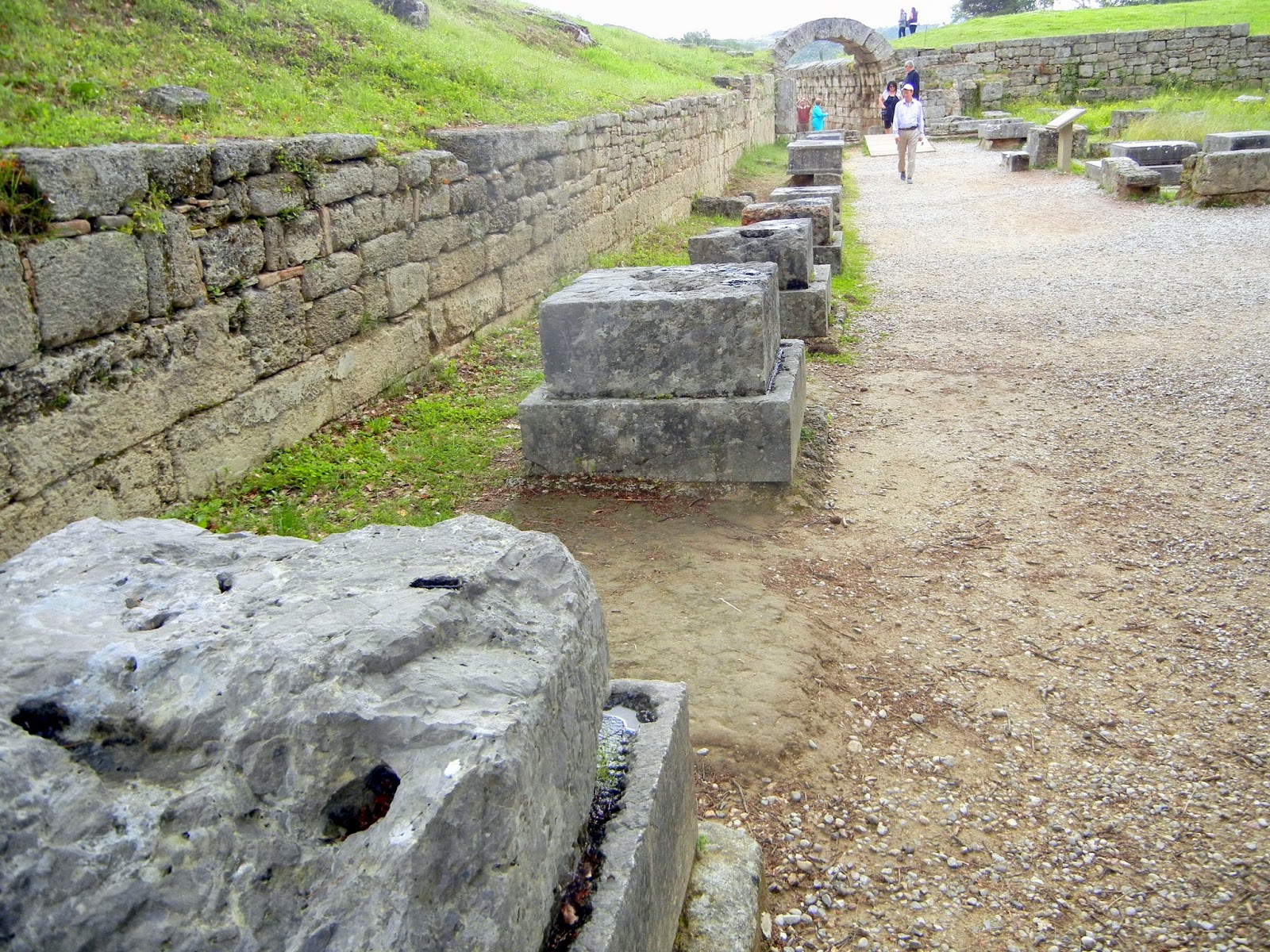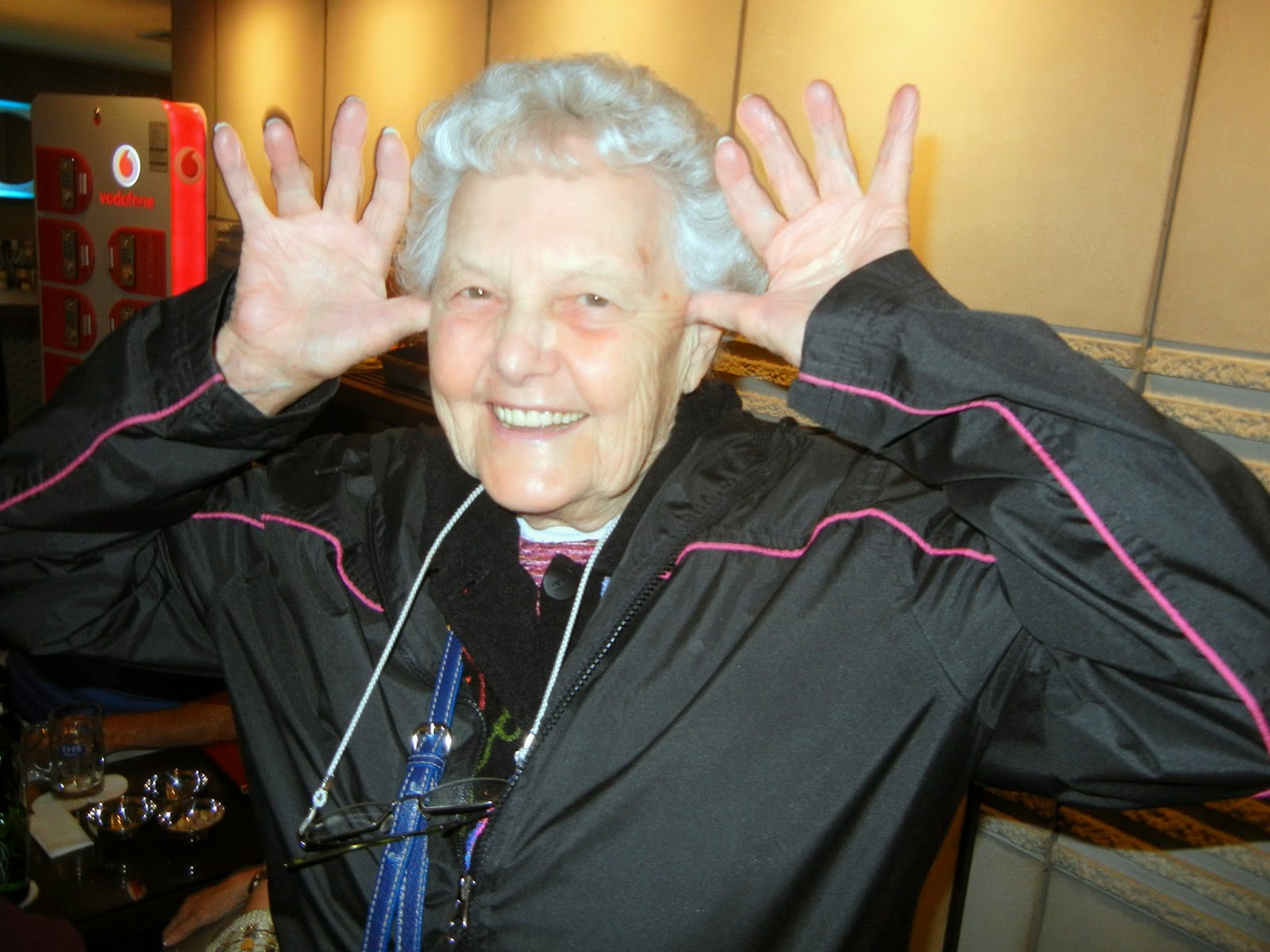After arriving at our hotel we are introduced to Theodora who is our guide - pictured at far left.
Theodora loads us aboard a bus for a tour of Athens.
Hans and Erica peek over the seat back while Bob and Ellen pull mugs for the camera.
More mugs . . . Sharon, Doug and Terri
Jim and Joan standing in front of the Panathenaic Stadium. completed in 1906 it was the site of the first modern Olympic games and seats 160,000 people.
The central hub of Athens is Syntagma Square, a popular tourist destination.
Changing of the guard at Syntagma Square.
Jim and Joan help guard the square.
Photo: Wikimedia
We visit the Acropolis, a series of temples dedicated to the Goddess Athena. The structures are undergoing extensive restoration.
Looking over the city of Athens with Dave and Colleen.
. . . and with Steve and Jan - the other Van Horns.
Theodora takes us for a walk through the shopping district.
Theodora takes us for a walk through the shopping district.
We stop for lunch where everybody forgets their diet including Joan and Sharon.
At last, some real Greek food.
Connie
MYKONOS
This is the seafood platter for two. (Yum)

Ephesus Turkey
From Mykonos our ship moves to the port of Kusadasi in Turkey where we board a bus that takes us to the ancient city of Ephesus.
Public latrines - the only non pay toilets in Turkey!
Mosaic tile floors.
Numerous frescoes are on display.

Looking down on the inner harbor.

On Patmos we visit the "Sacred Cave of the Apocalypse".




UNESCO has declared it a world heritage site.
40 monks currently call the monastery home.
Rhodes

At one time the population was around 100,000 people.
Santorini
In the picture you can see the very steep switch-back road that takes you from the ocean up to the level where the towns are.
Taking the tender from the ship to shore.
While on Santorini we visit the town of Oia.
The town sits on the edge of the caldera.
Which has a great view of the city.
So we pose for another group photograph.
Cook our own appetizers

We learn how to weave a rug.
Grind grain into flour.
Bake bread in a wood fired oven.

Time to eat.


Janet and Diane are digging in - bon appetit.
Later we are entertained by Greek folk dancers in traditional dress.

The above is a video of the Greek dancing group.

One of the restaurant staff gets into the act.


Above is a video of the broken crockery dancer doing his thing.
 Our first stop along the way is the Corinth Canal. Finished in 1890 the canal cuts through the isthmus of Corinth connecting the gulf of Corinth with the Saronic Gulf in the Aegean Sea.
Our first stop along the way is the Corinth Canal. Finished in 1890 the canal cuts through the isthmus of Corinth connecting the gulf of Corinth with the Saronic Gulf in the Aegean Sea.
The theater of Epidaurus.

All the way to the top.
Mycenae

Olympia

Istanbul Turkey

Drooling through plate glass.
Who knows what these are. (???)
Ice cream guy.

Sampling a Turkey (ish) dinner.
Turkish coffee.
Our group heads to downtown Istanbul to see the sights.

A lesson on proper dress.
Nothing can hide American beauty.


Properly attired we walk through the Mosque.
A typical Turkish street vendor. (The one on the left.)
These photos of Istanbul were taken from a rooftop restaurant.


Later we board our ship, the MS Louis Olympia and head out into the Aegean Sea for the first of our Greek Islands.
Heading ashore at the island of Mykonos. This photos was taken looking at the reflection from the mirror covered ceiling.
While on Mykonos some of us stop into a street side cafe for a snack.

. . . along with something to wash it down.
Ephesus Turkey
Constructed in the 10th century BC it was once home for about 50,000 people and the 4th largest city in it's time.
The homes were heated and had hot and cold running water.Public latrines - the only non pay toilets in Turkey!
Mosaic tile floors.
The "Terrace Houses" have been enclosed to facilitate and protect the ongoing restoration project.
Numerous frescoes are on display.
An optional tour at Ephesus was the "House of the Virgin Mary" - a site considered sacred to both Catholics and Muslims. The structure is thought to be the last residence of the Virgin Mary who was brought to Ephesus by the apostle John.
Photo: Wikipedia
PATMOS
On the island of Patmos we anchor out and take a boat tender into the harbor.
Joan gets a helping hand off of the tender.
Looking down on the inner harbor.

On Patmos we visit the "Sacred Cave of the Apocalypse".


The sacred site located inside a cave is where the voice of God dictated the text of the Revelation to Saint John.

The "Holy Monastery of St. John the Theologian" is a Greek orthodox monastery founded in 1088.

UNESCO has declared it a world heritage site.
40 monks currently call the monastery home.
Windmills constructed in the 14th century for flour production.
Rhodes
Next on our tour was the Island of Rhodes where we stroll through the walled city of Rhodes.
The city of Rhodes is one of the best preserved medieval cities in Europe.
The city is famous for being the site of the Colossus of Rhodes, one of the seven wonders of the world.
Sketch from history.com
Destroyed by an earthquake in 226 BC it was 100 feet tall making it one of the tallest statues in the ancient world.
That night after returning to the ship we all get together for formal night at the dinner table.
And for Ellen's Birthday
Happy Birthday Ellen
Crete
Next our ship docks at the port of Heraklion on the Island of Crete.
Sketch: Travelingclassroom.org
Where we travel by bus to the ancient Minoan Palace of Konosos which was the political center of the Minoan civilization during the bronze age.
The city is a maze of living spaces and work areas constructed around a central square.
Excavation and renovation began in 1900 and continues today.At one time the population was around 100,000 people.

Santorini
Animated jpg - Wikipedia
Last on our list of Greek islands is Santorini which is what remains after an enormous volcanic eruption destroyed an island creating the current geological caldera.
A giant central rectangular lagoon measuring about 4 miles by 7 miles is surrounded by 1000 ft high steep cliffs on three sides. The main island slopes downward to the Aegean Sea.
In the picture you can see the very steep switch-back road that takes you from the ocean up to the level where the towns are.
Taking the tender from the ship to shore.
The town sits on the edge of the caldera.
At long last our ship returns to Athens where we sadly depart taking many fond memories!
Connie leads us aboard the bus and we depart for our special evening of Greek food and entertainment.
At the Zafiro restaurant.Which has a great view of the city.
So we pose for another group photograph.
Cook our own appetizers
Erica enjoying her appetizer.

We learn how to weave a rug.
Grind grain into flour.
Bake bread in a wood fired oven.
Get tips on Greek cooking with Janet and the restaurant chef.
The band warms up.
While we learn how to do some traditional Greek dancing.
So far everybody is sober.

Time to eat.


Janet and Diane are digging in - bon appetit.
Later we are entertained by Greek folk dancers in traditional dress.




The other staff members start breaking crockery at the dancer's feet.
We depart for our hotel while the staff clean up the mess. The next day we board the bus for the land tour portion of our holiday.
 Our first stop along the way is the Corinth Canal. Finished in 1890 the canal cuts through the isthmus of Corinth connecting the gulf of Corinth with the Saronic Gulf in the Aegean Sea.
Our first stop along the way is the Corinth Canal. Finished in 1890 the canal cuts through the isthmus of Corinth connecting the gulf of Corinth with the Saronic Gulf in the Aegean Sea.
Photo: www.Greecemedtravel.com
Photo: www.sailingissues.com
EpidaurusThe theater of Epidaurus.
In antiquity, the theater of Epidaurus was admired for it excellent acoustics, symmetry and beauty. Today it is considered the best preserved theater in Greece. In 1881 the theater was discovered and renovated after being lost for centuries.
Here we see two visitors working their way to the top.
All the way to the top.
Mycenae
Leaving the theater of Epidaurus behind we rejoin the bus and travel to the ancient citadel of Mycenae. Dating from 1600 BC the citadel was a major center of Greek civilization and a military stronghold.
The Lion Gate marked the entrance to the city.
The "Grave Circle" is a burial complex where gold funeral masks and other artifacts were excavated in the 19th century.
Mask picture source is unknown.
Constructed around 1250 BC the "Treasury of Atreus" is thought to be a tomb once holding the remains of an ancient personage.

The lintel stone above the door is estimated to weigh about 120 tons.
Olympia

Theodora is still with us and now takes us to ancient Olympia, site of the most famous games in history.
The Olympic games were held every four years through classical antiquity from the 8th to the 4th century BC.
The stadium had a seating capacity for 45,000 people. Only men were allowed to compete or view the games. The above photo shows visitors competing in their own Olympic competition.
The original starting line.
Another of the seven wonders of the ancient world was the statue of the God Zeus at Olympia. The statue was much like the statue of Lincoln in Washington DC only it was over double the size. In Greek mythology Zeus was the God of the sky and ruler of all of the Gods. Image: clccharter.org
Delphi was internationally known for the Oracular powers of Pythia the priestess who had the power to foretell the future by speaking to the God Apollo. Greek and foreign dignitaries as well as common folk made the pilgrimage to the Delphi sanctuary paying great sums for Pythis's oracles.
The sanctuary of Delphi fell into Roman hands in 191 BC and was stripped of it's treasures.
The theater at Delphi accommodated five thousand spectators and presented the audience with a spectacular view of the entire sanctuary below the theater and the valley beyond.
The following photos are of some of the interesting and beautiful places we saw as we traveled across Greece on the bus.
Istanbul Turkey
At the conclusion of our tour of Greece we fly on to Istanbul for a few days of exploring.
At the heart of Istanbul is Takism Square. It is a major shopping area famous for its restaurants, shops and hotels.

It is also a popular place for locals to hold demonstrations. Some of which have resulted in injury or death to the participants.
Today the police are preparing for a political protest. This officer seemed proud of his machine gun and offered to pose while I took a picture of him holding it!
A young peace-nik complete with flowers in her hair.
Drooling through plate glass.
Who knows what these are. (???)
Ice cream guy.

After a day of walking around we stop for dinner.
Sampling a Turkey (ish) dinner.
Turkish coffee.
Our group heads to downtown Istanbul to see the sights.
Our group passes by the Walls of Constantinople which are a series of defensive stone walls constructed to surround and protected the ancient city of Constantinople - today's Istanbul.
We visit the Blue Mosque which was constructed in the early 1600's and a popular point of interest for visitors today.

A lesson on proper dress.
Nothing can hide American beauty.


Properly attired we walk through the Mosque.
A typical Turkish street vendor. (The one on the left.)
Later we visit the Spice Bazaar, constructed in 1660 it is the second largest covered shopping area in Istanbul.
Spices, dried fruits, cheeses, sausages, jams, nuts, seeds and other edibles fill the shops as well as jewelry and other goods.
These photos of Istanbul were taken from a rooftop restaurant.
Looking across the Bosphorus Strait which connects the Black Sea to the Aegean Sea.
Aerial image: Wikipedia.org
The strait also separates Europe from Asia. The near shore is in Europe and the far shore is Asia.
This was the last day of our tour of Greece and Turkey. The next day a bus took most of our group to the airport for their flight home while a few group members went on to other European adventures.
Please click on the image below to be transported to Jim and Joan's homepage.


.gif)
































.jpg)
.jpg)




